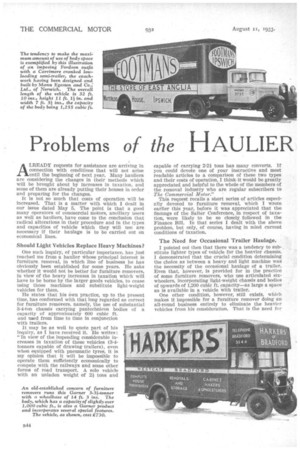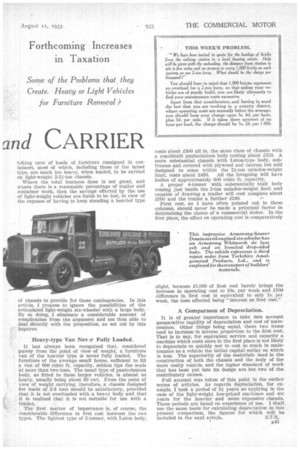Problems of the HAULIER grid CARRIER
Page 54

Page 55

If you've noticed an error in this article please click here to report it so we can fix it.
i
ALREADY requests for assistance are arriving in connectiOn with conditions that will not arise until the beginning of next year. Many hauliers are considering the changes in their methods which will be brought about by increases in taxation, and some of them are already putting their houses in order and preparing for the changes.
It is not so much that costs of operation will be increased. That is a matter with which I dealt in our issue dated May 5. The point is that a good many operators of commercial motors, ancillary users as well as haulers, have come to the conclusion that radical alterations in their procedure and in the types and capacities of vehicle which they will use are necessary if their haulage is to be carried out on economical lines.
Should Light Vehicles Replace Heavy Machines?
One such inquiry, of particular importance, has just reached me from a haulier whose principal interest is furniture_ removal, in which line of business he has obviously been established for some years. He asks whether it would not be better for furniture removers, in view of the heavy increases in taxation which will have to be borne by the larger goods vehicles, to cease using those machines and substitute light-weight vehicles for them.
He states that his Own practice, up to the present time, has conformed with that long regarded as correct for furniture removers, namely, the use of substantial 3-4-ton chassis carrying pantechnicon bodies of a capacity of approximately 600 cubic ft. and used from time to time in conjunction with trailers.
It may be as well to quote part of his inquiry, as I have received it. He writes :
In view of the impending considerable increases in taxation of these vehicles (3-4tonners capable of drawing trailers), even when equipped with pneumatic tyres, it is my opinion that it will be impossible to operate them sufficiently economically to compete with the railways and some other forms of road transport. A solo vehicle with an unladen weight of 2 tons and
capable of carrying 2-24 tons has many converts. If you could devote one of your instructive and most readable articles to a comparison of these two types and their costs of operation, I think.it would be greatly appreciated and helpful to the whole of the members of the removal industry who are regular subscribers to The Commercial Motor." ' This request recalls a short series of articles especially devoted to furniture removal, which I wrote earlier this year, before it was appreciated that the findings of the Salter Conference, in respect of taxation, were likely to be so closely followed in the Finance Bill. In that series I dealt with the above problem, but only, of course, having in mind current conditions of taxation.
The Need for Occasional Trailer Haulage.
I pointed out then that there was a tendency to substitute lighter types of vehicle for the heavier chassis. I demonstrated that the crucial condition determining the choice as between a heavy and light machine was the necessity of the occasional haulage of a trailer. Even that, however, is provided for in the practice of some furniture removers, who use articulated sixwheelers, incorporating light-weight chassis and bodies of upwards of 1,200 cubic ft. capacity—as large a space as is available in a vehicle with trailer.
One other condition, however, still exists, which makes it impossible for a furniture remover doing an all-round business entirely to eliminate the heavier vehicles from his consideration. That is the need for tilting care of loads of furniture consigned in containers, most of which, including those of the latest type, are much too heavy, when loaded, to be carried on light-weight 2-24-ton chassis.
Where the total business done is not great, and where there is a reasonable percentage of trailer and container work, then the savings effected by the use of light-weight vehicles are liable to be lost, in view of the expense of having to keep standing a heavier type
of chassis to provide for those contingencies. In this article, I propose to ignore the possibilities of the articulated light-weight six-wheeler with a large body. By so doing, I eliminate a considerable amount of complication from the argument and am thus able to deal directly with the proposition, as set out by this inquirer.
Heavy-type Van Nev.ir Fully Loaded.
It has always been recognized that, considered purely from the point of view of weight, a furniture van of the heavier type is never fully loaded. The furniture of the average small house, sufficient to fill a van of 600 cubic ft. capacity,' seldom tips the scale at more than two tons. The usual type of pantechnicon body, as fitted to these larger vehicles, is almost as heavy, usually being about 30 cwt. From the point of view of weight carrying, therefore, a chassis designed for, loads of 2-3 tons should be satisfactory, provided that it is not overloaded with a heavy body and that it is realized that it is not suitable for use with a trailer,
• The first matter of importance is, of course, the considerable difference in first cost between the two types. The lightest type of 2-tonner, with Luton body, costs about £300 all in, the same class of chassis with a eoachbuilt pantechnicon body costing about £350. A more substantial chassis with Luton-type body, ashframes and covered with plywood and canvas, but still designed to come within the 24-ton unladen-weight limit, costs about £430. All the foregoing will have bodies of approximately 600 cubic ft. capacity.
A proper 4-tonner with substantially built body coming just inside the 5-ton unladen-weight limit and capable of drawing a trailer will cost complete about £000 and the trailer a further £240.
First cost, as I have often pointed out in these columns, should never be made a principal factor in determining the choice of a commercial motor. In the first place, the effect on operating cost is comparatively slight, because £1,000 of first cost barely brings the increase in operating cost to 10s. per week and £100 difference in first cost is equivalent to only is. per week, the item affected being "interest on first cost."
A Comparison of Depreciation.
It is of greater importance to take into account comparative rapidity of depreciation and cost of maintenance. Other things being equal, these two items tend to increase in inverse proportion to the first cost. That is to say, for equivalent service and capacity a machine which costs more in the first place is not likely to depreciate so quickly nor to cost so much in maintenance as a vehicle the initial capital outlay on which is less. The superiority of the materials used in the construction of both the chassis and the body of the more costly vehicle, and the higher standard of work that has been put into its design are but two of the contributory causes.
Full account was taken of this point in the earlier series of articles. As regards depreciation, for example, I took a period of 34 years as applying in the case of the light-weight low-priced machines and six years for the heavier and more expensive chassis. Those periods are based on experience of use. I shall use the same basis for calculating depreciation in this present comparison, the figures for which will be
included in the next article. S.T.R.




















































































